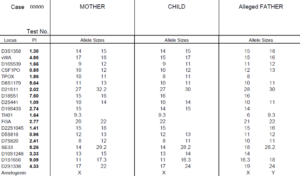Having finally made the decision to have a DNA paternity test UK, you may have concerns about the thoroughness of the process and how to understand the test report.
Reports can vary a great deal from one lab to another. The outcome of the test should be the same no matter which lab you use (as long as the lab is accredited and enjoys a good reputation), but the information provided to help you understand the test can be very different. When undertaking a paternity test from DNA Diagnostics Centre (DDC), we ensure we give you enough information that you can clearly understand the report.
Unlike many labs, we provide your DNA profiles so that, with the explanation, you can see for yourself if DNA matches or does not. Due to lab-certification requirements, the terminology used for DNA paternity test UK results must be scientific as well as legal, and so it can appear complex. But we’re here to make it easier! These are some terms that are commonly used along with their explanations to help you understand your report.
- Locus/Allele Sizes Table
- Combined Paternity Index
- Probability of Paternity
- Conclusion of Results
- Mutations
Locus/ Allele Size Table
The number of genetic panels normally tested by other labs is 16. At DDC we test 20 markers plus the amelogenin. The amelogenin identifies the sex of the individual being tested, so checking the amelogenin serves as an extra safeguard for identification purposes. Each profile is presented in a table with those for the child and father listed and also the mother (if she has been included in testing).

If for any reason the lab PhDs are not satisfied with the strength of the outcome, they will as a matter of course test more markers at no additional cost. If the lab decides testing additional markers is necessary, these also appear on your paternity test report.
Every child inherits one of their markers from their biological father and one from their biological mother. When mismatches appear between the alleged father and the child, the lab establishes if it is because he is not the biological father or if those mismatches are due to mutations. Using the data in this chart and the ethnic background of test participants, the lab uses a statistical calculation to come up with what is known as the Combined Paternity Index and the Probability of Paternity.
Combined Paternity Index (CPI)
The Paternity Index for each marker appears on the left side of the report under the PI heading. A mathematical calculation using all these PIs produces the Combined Paternity Index, or CPI. The rarer the loci value for the test participants’ ethnicity, the higher the PI. If a PI for a particular locus has a value of 0.00, then there is a mismatch between the child and the possible father at that genetic location.
The Combined Paternity Index can be seen as a number on the lower left hand side of the report.
The Combined Paternity Index is the genetic odds of how many times more likely it is that the possible father is the biological father rather than a randomly chosen and totally unrelated man with the same ethnicity. This number changes for each father and child and will also differ between children from the same father. This is because, unless they are identical twins, the children do not have identical DNA profiles.
If the father is the biological father of the child, you see a number next to the Combined Paternity Index. If the father is not the biological father, the Combined Paternity Index is 0.
Probability of Paternity
The Probability of Paternity (shown as a percentage) for your DNA paternity test UK is calculated from the CPI and indicates the chance of paternity based on the complete DNA test results.
A DNA paternity test UK result with a 0% probability of paternity means that the alleged father is excluded, or cannot be the biological father. The alleged father is proven to be the biological father of the tested child if a probability value of 99+% or over is achieved.
Why 100% Probability of Paternity is Never Possible
Although it is very common in paternity testing to get a probability of 99.99%, you can never get 100%, and here’s why: Because results are based on statistical calculations, it would only be possible to get a result of 100% if we tested every male of the same ethnicity as the biological father. Clearly, this would be impossible.
Mutations
Sometimes, an alleged father will not have the same number as the child at one of two loci. When this happens, we perform additional testing to determine whether the alleged father is excluded or not excluded as the biological father. After additional testing, if no additional loci exclude the alleged father as the biological father, a PI reflecting the mutation rate is listed on the report and a CPI and Probability of Paternity is calculated accordingly.
DNA Paternity Test UK Conclusion
When coming to a conclusion, the PhD includes all aspects of the test in the section found in paragraph form at the bottom of your report. With UK DNA paternity testing, there are only two possible conclusions; he is either the biological father or not the biological father. There is no middle ground.
We hope this information assists anyone to understand their test results, but if you have done your DNA paternity test UK with DDC and you are unsure of anything, our knowledgeable customer service team is always be happy to offer you additional explanations of assistance.

